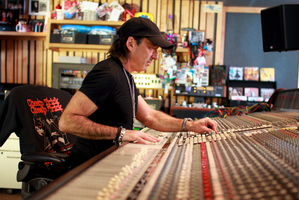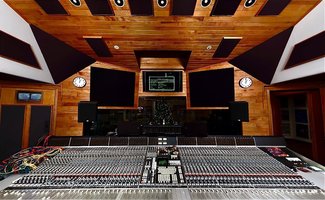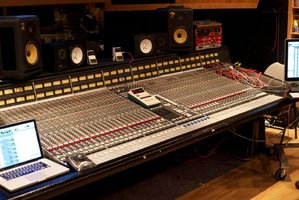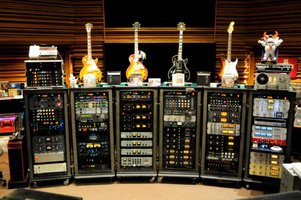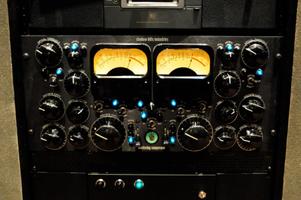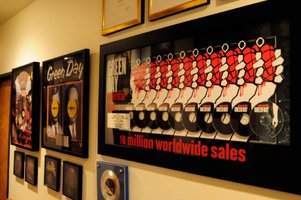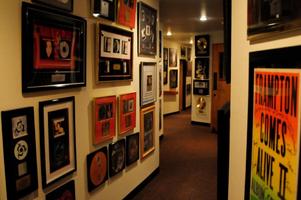World renowned mixer/producer Chris Lord-Alge granted Audiofanzine an exclusive interview. The man behind Green Day, Paramore, Deftones, Madonna, Tina Turner, James Brown, among others, shared his working methods and ethics from his studio in Tarzana. Let’s see what the master has to say.
The Beginnings
AF : Hi Chris, can you tell us what are you currently working on at the moment?
CLA : What I am currently working on right now is finishing up an album by a band called Shinedown, just wrapping that up. The single is already out to radio and then the record comes out. Just before I finished Shinedown, I just finished mixing Bruce Springsteen. I kinda co-mixed that with Bob Clearmountain. Bob mixed it himself and then Bruce wanted me to mix a few songs. I literally just had dinner with Clearmountain last night and we were definitely having some good laughs about it.
There’s a good partnership between engineers! I’d like to go back to the beginning of your career, and just to know a little bit more about how you started and the reasons for why you do this job today? What pushed you to become a sound engineer? Specifically, a mixing engineer…
It started with my mom having a band. My mom is a Jazz musician and a professor of music theory. She’d have her trio set up at my house, so here I am 12 years old and there are musicians rehearsing every day at my house, with tape recorders, a small board and a few microphones. Every chance I could get, when they would leave to go do a gig, I would take the gear down into my basement and let the experiments begin there.
So it’s a family thing?
Yes, absolutely, my mom is a musician, I’m a musician, it was just what I wanted to do since I was young, and by having some gear to tinker around with it was fun to start there. I already had my own band when I was 12, I just used that gear to start recording it. At that point I played keyboards, and then I moved to drums; I kind of filled in where the weaknesses in the band were.
Is there any personality or mentor who showed you the path or took you under his wing? Showed you some tricks, who gave you the will to do this, someone apart from your family?
Yes, of course! So what had happened was that my mom had realized that I really wanted to do this, so she took me to a studio to interview for a job. I got a job at H&L Records under the mentorship of Steve Jerome (GrandMaster Flash, Bobby O, Pet Shop Boys, NDA). They had hired me for $50 a week to be a runner, an assistant. I started with the toilets, to the tea, to the coffee, to the track sheets, until I finally became an assistant and then Steve Jerome had trained me and showed me how he’d like me to do it. He was in essence, my mentor at that time. When I was at a young age 13/14, he showed me the ropes, all the disciplinary moves that became embedded in my life.
So then I read that you’ve been working at Unique Sound Studios?
Well, let’s not cut to that straight away. I put in a bunch of years right there with Steve with Hugo and Luigi, and that studio ended up being taken over by Sugar Hill Records, which in essence was the birth of rap. So I was right at the beginning of rap, with Sugar Hill Gang’s “Rapper’s Delight”, GrandMaster Flash’s “The Message” and “White Lines”; all the big initial rap records were all done under that roof with Steve or with Eric Thorngren. So I was there for all of that.
What a period! So then Unique Sound Studios came later on?
At that point I started to work in New York freelancing with a few artists, and then I actually apprenticed to get a job. I went back down the food chain to be an assistant at Unique because I saw it as the cutting edge hip studio that was happening at New York at the time, at 82’- 83’. It kind of ended around 87’- 88’. I became an assistant and then staff, basically kind of took over, had a few reasonable hits, and then I just kind of took over working there. Just doing what I wanted.
So it was kind of the normal evolution : you started as a runner, then an assistant, and then as an engineer, very naturally.
Exactly. But you can always go back from an engineer back to an assistant, it helps put you in your place.
The fact that your two brothers are also working in the industry, was there any competition with the two others?
It’s pretty simple. My brothers worked with me; Jeff used to do live sound for my band, Tommy used to run the lights. Jeff started as my assistant in the studio first, and then I convinced Tommy not to do live sound and come and be my assistant also. Both of those guys started working with me and I trained them. Tommy, I basically dragged in, put him in front of every other assistant waiting in line to be my assistant and trained him right at the forefront. So was there any competition? Not really, because they are my brothers and we work together ! (Laughs) It wasn’t really about that, it was about : “There’s plenty to do, you want this gig, do it, or that gig, do it.” I don’t compete with my family! (Laughs) But absolutely, I have a very competitive attitude towards anybody else. My attitude is : “You better take your best shot, because I am not going down without a fight.”
Are there any working methods that you acquired back in the 80’s that still serve you today?
Well that’s an interesting question, because the reason why the business has changed is because all the engineers now weren’t brought up with the severe discipline of a mentor. They buy a ProTools rig, they buy a few plugins. They compress something and they think they are a mixer. And that’s not me being angry or derogatory, it’s about, you know what : until you have cleaned a few toilets, written up a thousand track sheets, have been beaten to submission wrapping up mic cables, putting away mics, and being completely intimated in front of every producer and artist that you can, you haven’t earned your wings to sit behind the desk. Not that I believe that my way is the only way, but I think there are a lot of guns for hire out there that didn’t even earn the gun.
So all the experience, it all pays off, but you learn something every day. It’s not just about being an engineer but about being a people person and dealing with the attitudes and the relationships with the artists. What you do behind the desk means nothing unless they are comfortable.
I am doing so many seminars to change the course of recording by getting every possible student a 3 or 5 hour lecture with me, at my cost with SSL, to come down and inspire them to show them the path that makes sense. And see who wants to be inspired and who doesn’t. And just try to push the next generation into the hot seat in the right way. I’m working that angle.
You consider education as something that’s really important. You are doing a lot to promote that.
CLA: Yes, here is an example. I call up the president of SSL, I say : “Look, I want to do a seminar for the engineering students in L.A. and I am going to host it in my studio at my cost. You bring a film crew, you bring the best 30 students you can, and I will give them 4 hours of pep talk about mixing, recording and everything. That’s great, here’s the date, let’s do it.” Now that’s in L.A. And then I said : “Let’s really move and now next weekend I’m doing another one at the Power Station in New York with another 30 students for SSL.” And after that I’m going to go to Real World – which is Peter Gabriel’s studio – and we’re going to do it for like a 100 students there. And speaking of Paris, I’m trying to orchestrate one because I’m doing a seminar called Mixing with the Masters in July in La Fabrique. So I am going to try to do something with Studio Guillaume Tell, I believe is the big one in Paris, using one of the big SSL rooms there and bring all the French or Swiss students and do a seminar there. I just want to do it at a room that has the big G console, so I can show them how I mix on that console, and a big enough room where I can get 30 or 40 students in there for the whole day, talking about the whole deal and giving them all the insight. ( I’ll probably need a translator.)
You still find it very important to show others how to do it and train people. Do you know how many assistants have you trained over the years?
I probably only trained 10 or 15, I’ve probably touched a few more, because assistants stay with me, they don’t really want to quit. Let’s put it this way, they want to quit every night because I am so annoying ! (Laughs) I have the best assistants in the world. They have been trained to the point where no one can mess with them and I give them that self-esteem and that attitude to completely outdo every other assistant on the planet. And that’s the mentality because the clients we deal with expect perfection, they expect you to be on 24 hours a day. It’s a hard job, you need a life too. I’m on duty 24 hours a day – and it’s not because I am mixing 24 hours a day – but because the artists are around the world and they are emailing and texting, they want to be taken care of. It’s a bit of a pain in the ass sometimes, but when Mick Jagger calls you or Bruce Springsteen or David Bowie or someone important calls you or texts you, you take care of them; that’s just what you do. It doesn’t matter what bottle of wine you are drinking or where you are. It doesn’t matter.
Can you remember mixing your first real hit? The moment where you left the studio and you said to yourself : «Wow, that song was really really cool or this album was so cool and I have great expectations for it» ?
I would say the earliest moment was when as an assistant under Steve Jerome we completely tracked and mixed a song called “The Message” by Grand Master Flash which became their biggest hit. I guess it was 81’ or 79’/80’. In that situation, Steve had mixed it and it was 8pm, he splits to go home, and the band is still hanging around and they are like “Hey, why don’t you mess with it a bit?”. So I end up making my own version, which only the mastering engineer knows for sure which one ended up as the release – mine or Steve’s. That’s where it crossed the line a little bit. You are the assistant engineer, that means when the engineer is gone, you are the engineer. So when the band asks you to do something you don’t say no. My first involvement in actually pushing faders on something that became large was that. After that point, the one that becomes obvious was “ Living in America” by James Brown, which was a huge Rocky hit in 84’ or 85’. I engineered and mixed the whole thing with Dan Hartman. I remember making the edit, the single version from a 7 minute album version down to 3 and a half. It was my first real stint at making a short version.
Do you remember the first mixes – where you respected the artist’s vision – but still had your own signature sound come to life?
The whole signature sound was created and came from Bob Clearmountain. As soon as I heard Bob’s first mixes… the first mix that I heard and liked was “Good Times” by Chic. People don’t really know that he mixed the Chic stuff. They think that he just did Bryan Adams and Bruce Springsteen, Huey Lewis, David Bowie, they don’t realize that some of his earlier stuff was so amazing. I didn’t even realize that at the time. I was more about what he did with rock. To me he had a signature drum sound. Right off the bat, for me it was the drum sound and the vocals that I just went after; being as good as Bob, if I could be in the same league with Bob back then, that’s what mattered. I was always striving to be like Bob. “ BLB “ : that was my whole thing ! (Laughs) Funny enough, sitting at dinner last night, it complements the reverse, he’s like “ Man, you must be able to hand pick anything because you are so freakin’ busy at this point”. And I said “I’m just trying to keep up with you. You are the one doing the Rolling Stones and Springsteen at the drop of a hat every day!” I think the signature sound comes from just how I hear it, and it was making the drums louder than they should be on all those early hip-hop records.
Making the drums louder than they should be is one of the first things that comes to your mind when doing your own signature sound?
Being a drummer I always heard the drums being really upfront, like “Oh my god, here they come!” Definitely some of my earlier mixes are really drum forward. And it’s still the case today, the records are pretty drum forward.
And the artists really like the “larger than life” drums today ! OK let’s move on to the technical side of your work. Let’s be a techie for a while.
Technique
I know you are set up at the former Can Am studios in Tarzana for a while now. And besides the SSL 4K, what was your reason for moving to this studio at the time?
It started out as a simple process of logistics. I lived in Tarzana and I’d commute to Burbank and Hollywood to work. I was not in my own studio, I was in a studio owned by someone else. After all this commuting and not being able to actually get home to my family because of the traffic… I had worked in Cam An in the 90’s – I mixed the Damn Yankees and John Wetten (Asia, King Crimson), I mixed a few records here back in 90’ – 91’. One day I drove down here to see if it was still here, and sure enough I walked in, and of course it was in disrepair and it was under some new ownership. I came in and looked at it and wow, I talked to the owners and said “Hey, I’d like to check that room out”. I started by leasing it, basically renting the room from the guy, and in one day, I’m like : “ I’m not renting the room, I’m buying the place. Let’s get this guy out of here.” After a few days I said this renting thing is not going to work, I’m just taking the whole place over. Screw it! I started by taking over the studio B side, and soon as there was a chance to buy Studio A, I bought it. There were a couple of other people interested in buying it, but I just steamrolled over it. My business manager said : “Look I don’t care how you do it, I’m taking over the studio.” It was a no brainer. Then though I didn’t really need both studios, I needed to have control of the whole facility because I needed to make it mine and under my control. The best thing about it is that it already came with the console I wanted. It just took me some reverbing. I am completely happy about.
I read that you are still using some 3348 tape machines for mixing. Can you describe a little the process and the reasons for using that? Are you still using the 3348 for mixing?
Of course. Even last night, Bob was getting a couple of good chuckles because he’s been off those tape machines for at least 5 or 6 years now. Look, they stopped making the tape in 2008. For me the format was the best format ever invented because it puts your song on a finite piece of tape that once you print the song on there as a multitrack it doesn’t change form. So there is no opening a session, there is no worrying about hard drive crashing, it’s on a piece of tape, it’s digital and I like the way the machine sounds and it’s all transferred digital from Pro Tools. So when the tape goes in the box after the album is done with the track sheet, it’s exactly where we left off when we mixed the record. Aside from it’s sounding good – which is always the number one reason – you know that, when you put it back on, it’s exactly where you left it. My work flow does not slow down because my assistant is preparing the next song while I am mixing the first song. It’s a bit of an antique, but not really. It’s sonically great. I have plenty of virgin tapes. It’s not going to last forever, but I still like all the things it brings.
So that leads me to another question. You have 48 tracks on the tape, I can figure that you have some ProTools sessions from your clients, so your assistant is doing some premixes to fit onto the 48 tracks… But if for example there is something in the string stem, and you’d like your assistant to redo the mixing of the stem how does it work?
Well it’s really easy. When you want to modify what is on the tape, you open the session, you make the changes and you punch it in. Say, in the bridge I want more high strings and less low strings, we just modify in the Pro Tools session, we punch it in and it’s done, backgrounds, whatever. Generally, even a 200 track song folds down pretty good without a lot of comps. And by comps I mean when there’s 4 tracks to 2 or 8 tracks to 2 or whatever. Most of it is hand-off’s. Which means a pair hand-off to a pair, which hand-off to a pair. We are so good at making the comps be as uncompromising as possible so the master tape is still not just a comp, not just a stem reel. Plus we have the original sessions it came from. So that work perfectly also if we ever want to spread it out.
So it forces the mixing process to make decisions very early if the client doesn’t do so.
Right, it makes all the difference because it makes no matter what you get, manageable.
Which monitors do you use?
I still use 3 sets of monitors. I still use the original NS10’s with covers on them from the 80’s with the original Yamaha 2002M poweramps and a subwoofer, which is an Infinity BU2. Then I have the M&K top of the line powered speakers with two subs, to hype it up a bit more. And still a Sony ZS-M1 boombox which is, you know, managed right off the console feed and it’s in a rack. So between those 3 monitors it’s plenty.
So do you have any monitor controller or are you using the monitor management form the SSL?
It’s just what is built up to the console. It’s an A/B monitor, it’s minis, and then large. And then your boombox is basically your studio loudspeaker vibe control so it’s all off the bus at the console.
 I have some questions about the Waves plugins you developed with the Waves guys. Can you just tell us a few words about the process of doing that, and how the idea came about?
I have some questions about the Waves plugins you developed with the Waves guys. Can you just tell us a few words about the process of doing that, and how the idea came about?
It really started when they were coming out with their SSL E Channel Strip, which is exactly what I sit in front of for 30 years or since the SSL came out. They came after me and said : “Look, can you listen to these and tell how you think they sound?” I helped them modify them and make them as good as they can be, and they became the most popular plugin they ever sold. I still use them to this day as they are really simple and they are exactly what I know. We started with the SSL emulation, which I made some presets for, after that point it became : “Look, let’s make copies or emulate my 1176’s LA3A’s and LA2’s because I use them every day.” So they came out with the CLA76, LA3, LA2, all that. They actually took my original units to Tel Aviv for months, they scoped them, we went back and forth until they sounded distorted enough, and I was really happy with the result, the gooey, the whole deal. Once we did that, then it was like : “Design your own plug in!” Then I literally took a cocktail napkin with Mike Fradis – who is product manager – at a steak house one night and wrote the original design for the Signature plugins which look like little mixing boards with buttons on it, something really simple for the user.
 I’ve been using the CLA Bass or Vocals and they sound really great. It’s compiling some of the units or effects that you use a lot of time like reverb, delays, presets for the reverbs, voice doubler : it’s basically taking the chain that you are using on those instruments?
I’ve been using the CLA Bass or Vocals and they sound really great. It’s compiling some of the units or effects that you use a lot of time like reverb, delays, presets for the reverbs, voice doubler : it’s basically taking the chain that you are using on those instruments?
Well the thing I was trying to accomplish, have a plug-in for the new user so they could just have my Signature plugins only. And that’s all they would need because it has everything you want built in. The thing that you have to have sends and returns that’s a pain in the ass after a while. Believe me, I know, you have to set up sends and returns, and it’s complicated. This, you could just drop it in on everything and you have EQ, compression, gain, preamp, all that in one plugin. I think it conquered it. Look, if you want to get more detail then you can get some separate delay plugins. It’s really made for like 80–90% of your mixing you can use those.
Do you use your native plugins as well on ProTools sessions?
Of course. If I am looking for one of the effects I want, I always use mine.
So it’s you and your assistants who use the plugins in front of the mixing during the Pro Tools process. You can use the plugins there and then everything is transferred to the 3348, and then it is you with the SSL and the outboards.
Exactly!
So you work hand in hand with your assistants, you have a special partnership with them. They are very complementary to your work. I can figure that they are really important for you while you are working. They have to be trained very well to let them mix stems and things like that.
Well of course. The most important thing is when the clients are in here, they want to experiment and do some things, move some vocals around, do some editing, move some backgrounds. My assistants just pay attention and make it happen, just punch it in.
The outboard gear that you use, for example the 1176 or LA3A, are pretty much inserted on the same desk channels and then you have the same kind of track sheet for your 3348 tapes, then the drums from, let’s say, track 1 to 10, then bass, then guitars…? You pretty much have the same workflow all the time?
Right. The most important thing is making the song work. So if you have to figure out where all the parts are coming from that becomes a real struggle. That becomes difficult. I take all the difficult stuff out of the equation, then all I am doing is focusing on the song. When you go to reach for where the drums are, they are always at the same faders. They are not always the same sound, but they are always at the same place. When you are chef in a kitchen, you know where the knives are, you know where the flour is, you know where the cutting boards are, you know where the pans are. When you go to create an inspirational meal, all your tools are in the same place, but you always create something different. That’s the mentality.
Let’s go back to the instruments a little bit. Can you describe to us what you use for basic rock instruments? Like drums, bass, guitars, keyboards… What do you use most of the time as outboards on drums, for example?
The first thing you do is put all the faders up and find where the song is. If you go solo the drums I take all the compression off, so I start to balance them with no compression. Literally. And I see which samples I need to add to make the drums come alive. Then I see if I can get away with no compression. Once you start putting the other instruments in, if the drums aren’t speaking enough, then I say : “Ok, I have to compress the overheads, or I have to compress this room track.” I try to do the least amount of damage because I can just start by compressing the bejesus out of everything, but then it just starts to sound backwards and dull. I try the least amount first, and add just a little bit at a time. A lot of it is how much room or reverb I am using. I have 6 different reverbs and I just feather them in to taste. It’s not like I : “ Ok, I am going to use this reverb on this snare drum”; it’s more : “I am going to use these 4 reverbs on the drums or these 6 reverbs that are just on one send.” It’s a palette. I have 14 different reverbs set up – in total – and I will just push those returns up and see which ones, like : “This balance is working great for the chorus, this balance is working great for the verse”, it’s more that. It’s not like an exact science, but you are definitely using digital reverbs, some typical analog compression, and EQs all off the desk, plus there are a couple of Pultec’s helping the kick and snare. So we are definitely using some old school technique.
Speaking of reverbs, what are your favorite reverbs?
My favorite ones are EMT246, originally Yamaha Rev1, a Sony DRE2000, an EMT252. The Lexicons I use are the 224 and 480 originals, which have their own sound. Then there are the newer ones, the Bricasti M7, which is probably the only new reverb I use. But then I also use an AMS reverb, the Ursa Major Space Station, which is not really a reverb, but somewhere in-between. And then there is also the Eventide SP2016. They are all chained together, all getting used. Sometimes I am using 4 or 6 of them at the same time. They are all on their good settings, and sometimes I just adjust the times. You can’t really beat the original digital reverbs.
If you are using up to 6 reverbs on the drums, I can imagine that you can do the same for the vocals…?
The vocals have their own line of delays. The vocals have 6 delays that I can use, and in 4 different channels of slap that I can use as a package, and then vocal doubles and then specific vocal reverbs. They have their own arsenal of stuff. Between the vocal reverbs and the drums reverbs, that covers everything.
Talking about outboards, are there any outboards apart from the 1176 and the LA3A that you use all the time? Like Pultec’s?
There are always 2 Pultec’s going, all the delays and reverbs are always engaged, they are always sending, it’s just how much you’re returning it. Some songs I look back and I go “Oh I am only using 3 compressors on this” and some songs I look back and I am using 23 compressors on this, and then some songs need all 8 reverbs to make it do something. It’s all dependent on what the tune is. By having all those faders available, here’s some more flavor, here is some more reverb, here is some more delay. You just texture. It’s like the sous-chef ! (Laughs)
What about new gear? Have you seen some new pieces of equipment that made you feel like you want to have it? New compressors? New EQs that have just been released?
As far as new compressors go, the Shadow Hills makes these new compressors. I use a whole bunch of those : their mastering compressor and their 500 series compressors. Steve Firlotte makes his own Inward Connections compressor, I use the new ones, the FETs; I even hand built my own 1176s with my tech staff, they just make new sounding ones. The ones I use the most are the Retro 176’s, they are brand new, those new tube limiters, they are great.
What about the Vac-Rac ?
Yeah, the Vac-Rac are fairly new. I use new and old. Of course there are some new delays and reverbs I use, even the Line6 EchoPros are still relatively new, the TC reverb and all that, that’s all brand new stuff.
What is your mix bus processing chain? Do you have some compressor and EQ inserted on the mix bus or do you print your track with the compressor on?
Well, your mix is your mix. The compressor is built in, you never unglue it by turning the compressor off, and I am not really compressing it that much. It’s either the Shadow Hills mastering compressor on the bus or the Focusrite Red 3, which is an original Red3, a very low serial number early ones. It sounds different than the new ones. For EQ’s, I have some mastering Pultec’s that I use on my mix bus so the whole mix goes through tubes and transformers.
How do you print the mixes? Do you print to them a ProTools session through which converter? How many versions can you do?
It’s always a six-pack and it’s always printed through the Apogee Symphony at 192kHz.
Ok so you do main mix, playback, instruments….
You do master mix, vocal up, TV track, instrumental, then you do lead vocal acapella, and background vocal acapella. And then, no matter what version you have; if there’s a single edit, there is six versions of it. If there is a long edit, there’s six version of it. If there is a clean edit, there are six versions. So everything becomes six. This way the artist has a TV instrumental that matches every configuration you have.
Artistic and Human Point of View
I’d like to talk a little bit about the relationships you have with producers, you have been working a lot with Don Gilmore. Are there any other producer’s you like to work with?
Let’s get to the right names here. The producer I mixed the most records for is Howard Benson. Howard Benson and I have done at least 100 records together. We started working in 98’. It could be more than that. One of these days I am going to have one of my guys tally it up, but I’d say it is pushing the 1500 to 2000 song limit. After Howard Benson, another client is Rob Cavallo who is now in charge of Warner Bros. I have been mixing his productions since the 80’s. He produces Green Day, he produces Shinedown, he produced some great bands : the Goo Goo Dolls, the Dave Mathews Band. He’s the second runner up. Then if falls to Don Gilmore, Matt Serletic, John Fields, and then it is everybody else at that point – Rick Rubin… Just the list goes on with the producers. I’m skipping names off the top of my head, but I want to make sure that I put them in order; Howard, Rob, are the key players. Bryon Gallimore, I’ve done all the country records with for 10 years. There is definitely a loyalty and an attitude that we can do whatever you want, whenever you want always.
What’s your advice to any mixer or student aspiring to become a mixing engineer?
The advice is : your relationship with the band and the producer is what makes your job. Unless you have a relationship with the band and the producer and they are happy with what you do, and want you to do it all the time, you don’t really have a title then. That really defines who you are. The band wants you, the producer wants you, the record company wants you to be doing it, and they are happy with what you do, then you can consider yourself a mixer at that point.
How do you see the evolution of the business now? The record business crisis at the moment, and it’s happening in every country…. How do you see the evolution of making records and selling music today?
I think today is the new frontier. People still, no matter what, want music. We just want them to pay for it. They are paying for it in a different way. We have to be more creative in how we make it. To be more efficient in how we make it. Bottom line is, bands still want to make music. Bands still want to record, and bands still need you to mix. We’re still going to have people buying the music, we just have to keep them from stealing it. I think the excitement is more than it has ever been.
That’s a very positive point of view.
Everyone is just doom and gloom. Well, that’s just your attitude. If you want to be a doom and gloomer, go work in a different business. But as far as I am concerned, music is only going to get better, and you just have to be positive and make it happen.
Part 4: The Bernard Pivot Style
What’s your favorite memory from mixing an album or working on an album?
My favorite memories would probably be from records I produced. They are all favorite memories, it is hard to say “this was the best”. I think the ones I got the most laughs on were albums I produced by Tina Turner, or John Miles or Rick Price or Joe Cocker, where being the producer, it was basically tweaking your last rough mix, with the artist in there and having some laughs and some fun with it. Knowing that you are playing on it and you’re producing it… And it came out great and you are excited. Rather than, mixing something that you didn’t produce. Of course, working on “American Idiot”, which went by so fast… It was exciting because the songs were so good and you didn’t really realize it at the time. But the best memories are definitely the ones I produced because there is more at stake because you are a producer. Human wise, because you are artistic about it, you play parts of it, there is more “blood” on the tape, than you just mixing someone else’s record.
You mean that this job is 60, 70% human aspect?
It’s 100% human. It’s not a business at all. It’s a personal, emotional business, that unless your heart is into the song, you’d might as well go back into the car and go home. You have to be emotionally attached to the music or there is no point in doing it.
Your worst memories/moments from mixing of all time?
There have definitely been some moments, I am not going to name the bands, but that had full-on fights in here internally with the band mates. No one agrees with what you are doing. Each guy leaves the room and comes back with a different idea. It makes it really difficult when the band doesn’t get along. There have been a couple where the band is breaking up or fighting at the time you are mixing it, or completely unsure of what you are doing. It’s not you, it’s them, and that’s what makes it difficult. A lot of the best records I ever mixed are when nobody is here but me, and I say this to them. Sometimes, they are their own worst enemy. It’s not their fault. They are really better off coming toward the end. When they want to come in here and do battle with it, sometimes they can unglue some of the magic that you’ve put into it by isolating their favorite parts.
Which artist would you still like to work with and why?
I want to work with Paul McCartney, I want to work with Coldplay; I want to actually mix a full fledged U2 album, not just one or two songs like I have done in the past, I want to be in the room with the band. I’d like to mix a new Rolling Stones record with the whole band in here. I want to go after the last of the mohicans, the biggest guns that are left while they still have something. It’s more the absolute legends of rock and roll that I prefer to be working with. Of course, I want to work with Muse and Foo Fighters and all the newer bands, but still they have some time. I want to get the old guys while they still got some action. I want to get it while there is a chance.
You’re engaged to mix an album for an artist you love but the requirements are : less is more. You have to pick only 5 pieces of your equipment. Which do you choose and why?
If I can pick only 5 pieces of equipment, I’d pick my favorite vocal limiter, I’d pick my favorite vocal reverb, drum reverb, that’s three…
Which ones?!!
It would be my Urei Blue1176, my original EMT246, my Sony DRE 2000, then it would be a pair of Pultecs on my bus, and my Focusrite Red. The Pultecs I say they are one piece of gear cause they are a pair.
You are cheating! (Laughs)
They come as a pair. With those 5 pieces of gear in a rack, I can go anywhere !
Just to finish up this interview, do you have any leitmotiv or quote/catch phrase about music that you like to use?
One of the things we say in the studio is “Don’t try this at home”! (Laughs) Everything I have here is not going to work at home. It’s really meant to be in the proper facility, in a temple of sound. Not your garage. For me it doesn’t work!
Thanks to Sarit Bruno (Chater-La) for making this interview happen… and for the transcription :)
This interview has been led by Bootz – www.lesliensduson.com . Photography by Brian Petersen.
Chris Lord Alge, Waves and Audiofanzine have teamed up to present a song competition:



